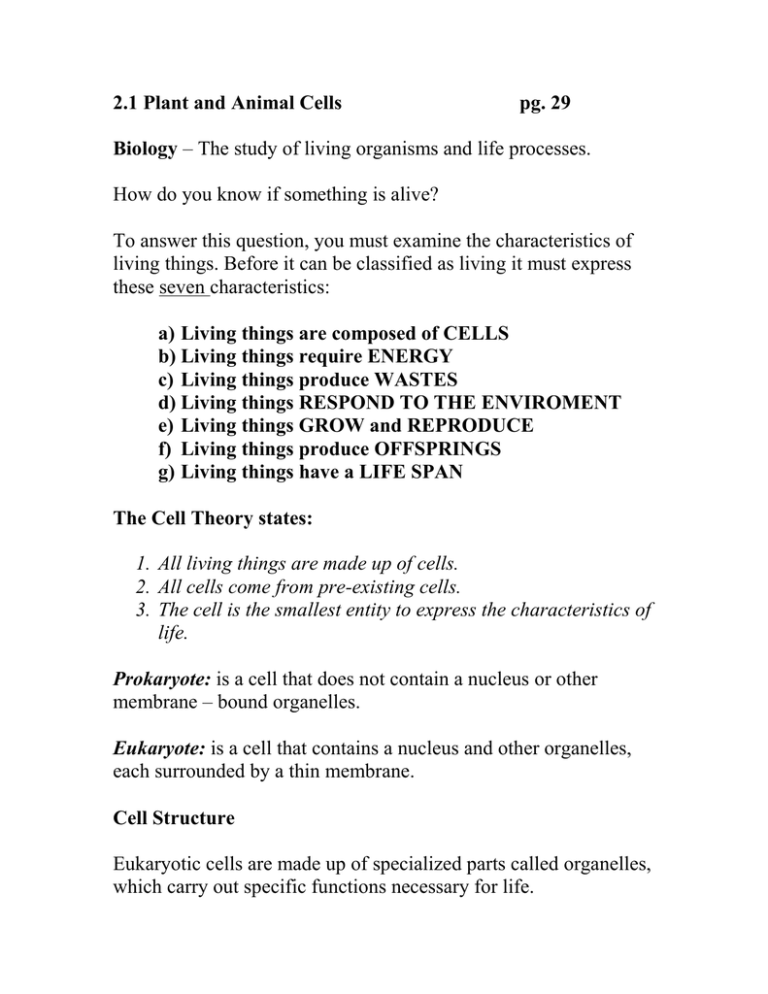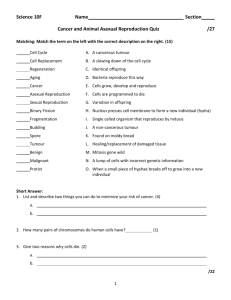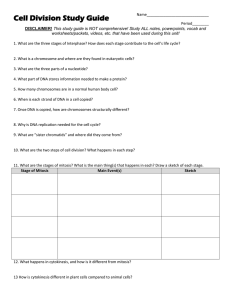2.1 Plant and Animal Cells pg. 29 Biology
advertisement

2.1 Plant and Animal Cells pg. 29 Biology – The study of living organisms and life processes. How do you know if something is alive? To answer this question, you must examine the characteristics of living things. Before it can be classified as living it must express these seven characteristics: a) Living things are composed of CELLS b) Living things require ENERGY c) Living things produce WASTES d) Living things RESPOND TO THE ENVIROMENT e) Living things GROW and REPRODUCE f) Living things produce OFFSPRINGS g) Living things have a LIFE SPAN The Cell Theory states: 1. All living things are made up of cells. 2. All cells come from pre-existing cells. 3. The cell is the smallest entity to express the characteristics of life. Prokaryote: is a cell that does not contain a nucleus or other membrane – bound organelles. Eukaryote: is a cell that contains a nucleus and other organelles, each surrounded by a thin membrane. Cell Structure Eukaryotic cells are made up of specialized parts called organelles, which carry out specific functions necessary for life. Organelle: is a cell structure that performs a specific function for the cell. Structures Common to Plants and Animal Cells All cells must perform the same basic activities to stay alive: Use energy, store materials, take materials from the environment, get rid of wastes, move substances to where they are needed, and reproduce. Each organelle has a specialized function in the cell, the various organelles work together to meet the needs of the cell, and the whole organism. Figure 2: Plant and animal cells have many of the same organelles, but there are some differences. Cytoplasm: jelly like liquid that is mostly water, which suspends organelles, stores many substances need by the cell, and where many chemical reactions occur. Cell Membrane: made up of a bi-layer of phospholipids molecules, which is very flexible and will not break. The function is to control what enters and leaves the cell, it allows some items to pass, such as; water and stops other, such as; proteins. Therefore the membrane is said to be semi - permeable. Nucleus: The nucleus contains the genetic information which instructs the cell on it cellular activities. Chromosomes are made up of DNA (deoxyribonucleic acid), is the coded information that controls cellular activities. Each cell must have a complete set of chromosomes, 23 pairs (46) for human cells. Mitochondria: is the „power plant‟ of the cell. This organelle is responsible for cellular respiration, producing ATP, which used by the cell as an energy source. Cellular respiration uses glucose and oxygen as reactants and produce carbon dioxide and water as waste products and ATP. Glucose + Oxygen → Carbon dioxide + Water + ATP Golgi Bodies: (Golgi apparatus) are responsible for collecting and processing materials (proteins). Golgi bodies are also responsible for producing and secreting mucus. Vacuoles: is a fluid filled sac, and have various functions within the cell. The containing some substances, removing unwanted substances from the cell, and maintain internal fluid pressure. . Organelles in Plants Cells Only Plant cells have the same structures as animal cells, but also have some additional organelles. Cell Wall: surrounds the outside of the plant cell. It is made up of cellulose and maintains the rigid shape of the cell and is porous to substances. The cell wall supports the cell and protects it from and physical injury. Central Vacuoles: one or two large vacuoles, which take up most of the internal space of the cell. They maintain turgor pressure and the keeps the cell plump. If water level drops the plant becomes flaccid because of a loss of turgor pressure, and begins to wilt. Chloroplasts: are specialized organelles found in plants responsible for photosynthesis. These organelles contain a green pigment called chlorophyll, which captures light energy. Light energy + Water + Carbon dioxide → Oxygen + Glucose Check Your Learning, questions 1 – 8, pg. 32 2.3: The Importance of Cell Division pg. 36 How does a single cell created through fertilization, become a fullgrown multicellular plant or animal? Cell Division for Reproduction The ability to reproduce is an important characteristic of all living things. All cells, singled celled and multicellular organisms, use cell division to reproduce. The parent cell produces two daughter cells, carrying the exact same genetic information to that of the parent cell. This type of reproduction is called asexual reproduction. Asexual Reproduction: is the process of producing offspring from only one parent; the production of offspring that are genetically identical to the parent. Multicellular organisms also reproduce to pass their genetic information along to their offspring. Some reproduce through asexual reproduction, while other reproduces through sexual reproduction. Sexual Reproduction: is the process of producing offspring by the fusion of two gametes; the production of offspring that have genetic information from each parent. The cell from one parent must fuse to one cell from another parent. The cells used to produce a new individual must contain only half of the DNA compared to a normal cell. These cells are produced by each parent are called sex gametes, female an ovum and male a sperm. These sex cells are created through a produce called Meiosis. Cell Division for Growth Organisms grow, and the number of cells which they are made up of increases. Cells don‟t just increase in size, but increase in number. All cells require energy, nutrients, water, and oxygen to survive. Chemicals that enter or leave a cell must be dissolved in water, creating a solution. These chemicals are used in chemical reactions that occur within the cell cytoplasm. The chemicals used during cell activity and growth enter the cell by passing through a cell membrane. This movement occurs through a process of diffusion. The chemicals move from an area of high concentration to an area of low concentration with expending energy by the cell. Waste products move in the opposite direction when leaving the cell, by the same process. Diffusion: is a transport mechanism for moving chemicals into and out of the cell, from an area of higher concentration to an area of lower concentration. Concentration: is the amount of a substance (solute) present in a given volume of solution. Osmosis: is the movement of fluid, usually water, across a membrane toward an area of high solute concentration. Cell Division for Repair Everyday your body sheds millions of dead cells, which are replaced by new ones. Red blood cells are replaced every 120 days. All organisms need to repair themselves to stay alive. Check Your Learning, questions 1 – 6, pg. 37 2.5: The Cell Cycle pg. 40 Interphase: is the phase of the cell cycle during which the cell performs its normal functions and its genetic material is copied in preparation for cell division. It is the longest stage of the cell cycle, and performs all the life functions; growth, cellular reproduction and specialized functions. The Cell cycle is broken into three parts; G1 – growth and development, S – DNA Replication (synthesis), and G2 – continued growth, cell functions and the preparation for cell division. Cell Divisions Cell division occurs in two parts; Mitosis and Cytokinesis. Mitosis: is the stage of the cell cycle in which the DNA in the nucleus, is divided; the first part of cell division. Mitosis consists of four phases, Prophase, Metaphase, Anaphase and Telophase (PMAT). Prophase: is the first stage of mitosis, in which the chromosomes become visible and the nuclear membrane dissolves. The chromosomes, long strands, short and thicken into a compact form. They have already replicated, and are known as chromatid sister pairs, which are held together at their centromeres. The nuclear membrane disappears and allows the chromatids to freely float in the cytoplasm. Chromosomes: are structures in the cell nucleus made up of a portion of the cell‟s DNA, condensed into a structure that is visible under a light microscope. Chromatid: is one of two identical strands of DNA that make up a chromosome. Centromere: is the structure that holds chromatids together as chromosome. Metaphase: is the second stage of mitosis, in which the chromosomes line up in the middle of the cell. The chromatids align along the equator, and it appears to have spindle fibres attached to their centromeres which also run to the opposite poles, attaching to the centrosomes (centrioles). Anaphase: is the third phase of mitosis, in which the chromosomes split at their centromeres and sister chromatids separate into daughter chromosomes, and appear to be pulled by the spindle fibres, each moving toward opposite ends of the cell (poles). Telophase: is the final phase of mitosis, in which the chromatids unwind and a nuclear membrane reforms around the chromosomes at each end of the cell. Cytokinesis: is the stage in the cell cycle when the cytoplasm divides to form two identical cells; the final part of cell division. Daughter cell: is one of two genetically identical, new cells that result from the division of one parent cell. Cell Division – The Big Picture Figure 6: The stages of cell division Checkpoints in the Cell Cycle At each checkpoint, specialized proteins monitor cell activities and the cell‟s surroundings. Messages are sent to the nucleus which then determines when the cell will divide. The cell will remain in interphase and not divide if; * Signals from the surrounding cells tell the cell not to divide. * There are not enough nutrients to provide for cell growth. * The DNA within the nucleus has not been replicated. * The DNA is damaged. Damaged cells are usually destroyed, if they can not be repaired. Check Your Learning, questions 1 – 7, pg. 44 2.7: Cell Division Going Wrong: Cancer pg. 48 Cancer is a group of diseases I which cells grow and divide out of control. Cancer is caused when the DNA has changed and the cell not longer stays in interphase for the normal time period. Finally one or more checkpoints have failed. All organisms can develop cancer if their DNA is modified. Environmental factors, chemical pollutants, UV rays, and radiation are some factors that can cause cancer. Some cancers are genetically inherited, but cancer can not be caught from some one who has it. Cell Growth Rates and Cancer Cancer occurs when the cell uncontrollably divides and checkpoints fail to stop the dividing. This uncontrolled division causes rapid cell mass growth, known as a tumour. Tumour: is a mass of cells that continue to grow and divide without any obvious function in the body. Benign tumour: is a tumour that does not affect surrounding tissues other than by physically crowding them. Malignant tumour: is a tumour that interferes with the functioning of surrounding cells; a cancerous tumour. The original (primary) tumour is located in one spot and when some tumour cells break away and move to a different location in the body. At the new location the tumour begins to grow and causes cancer at this new location. Metastasis: is the process of cancer cells breaking away from the original (primary) tumour and establishing another (secondary) tumour elsewhere in the body. Figure 1: A tumour is a mass of cells with no function. A tumour can remain benign, or it can become malignant. Tumour cells can metastasize, spreading to other areas of the body. Malignant and metastatic tumours are considered cancerous. Causes of Cancer When cells divide, the DNA is replicated (exact copy of the parent DNA), and the process is error free. When errors occur in the DNA it is known as a mutation. The cells may die, but if they live and replicate, they copy the error DNA and pass it on to the daughter cells. Mutation: is the random change in the DNA. Cancer cells will continue to grow out of control, until all nutrients are used and the surrounding healthy cells die. Carcinogen: is any environmental factor that causes cancer. Environmental factors, such as; Tobacco smoke, radiation (X-Rays and UV Rays), some viruses (papillomavirus HPV and Hepatitis B), certain chemicals in plastics, and many organic solvents. Smoking and Cancer Lung cancer is the most common type of cancer in Canada for individuals over 40 years of age. Smoking is the cause 9 out of 10 cases of lung cancer. Smoking is also a contributing factor in a dozen other types of cancer. Lung cancer can be prevent by not or giving up smoking in the first place, second hand smoke is also dangerous. Figure 3: The carcinogens in tobacco smoke can affect all of these parts of the body. Cancer Screening Cancer screening means checking for cancer even if there are no symptoms. Screening can be done at home, medical checkups, or special appointments. Screening is even more important for people with a family history of cancer. Females – Pap test – used regularly to detect for early signs of cervical cancer. Males – PSA test – used to detect prostate cancer. Skin checkups by the doctor or dermatologist are important, to look for changes in moles, new growths, and sores, to prevent cancer. The “ABCD of Moles”: A – Asymmetry, B – Border, C – Colour, D – Diameter. [See Table 1: The ABCD of Moles, Benign vs. Malignant, page 50.] Reducing Your Cancer Risk Cancer prevention and early detection are very important. The risks include personal, family medical history, carcinogens in your environment, and life style choices. You can make life style changes, which can have a big impact o you likelihood of getting cancer. Lifestyle Choices You can reduce you risk of catching cancer getting eating a healthy diet, including more fruits, vegetables, and decreasing fatty meat intake. Super foods contain substances that help protect your body from cancers. These foods only lower the chance of getting cancer, it does not prevent cancer. Figure 4: These cancer-fighting “super foods” are rich in many substances that help keep you healthy. Diagnosing Cancer Imaging Technologies Treatments for Cancer Cancer treatment tries to slow down the growth of tumours, or destroy as many cancer cells as possible. There are three main methods for treating tumours. Surgery: physically removing the cancerous tissue, and is sometimes preferred. Chemotherapy: The method uses drugs to combat the tumour, by slowing or stopping the cancer cells from dividing and spreading to other parts of the body. The drugs can be injected or taken orally. There are side effects are; hair loss, nausea, and fatigue. The benefits are greater then the side effects. Chemotherapy is the first stages of cancer treatment. It will shrink the tumour prior to surgery. Radiation: Ionizing radiation kills cells, by preventing its ability to divide. The radiation must be directed at the tumour using a focused beam. Check Your Learning, questions 1 – 10, pg. 55 2.9: Specialized Cells pg. 58 Specialized Cell – is a cell that can perform a specific function. The Cell Theory states: 1. All living things are made up of cells. 2. All cells come from pre-existing cells. 3. The cell is the smallest entity to express the characteristics of life. A single cell follows the cell cycle. During mitosis the nuclear material is divided up equally. Cytokinesis occurs and the cytoplasm and its organelles are divided up amongst two new daughter cells. This process ensures that the two daughter cells are exact copies of the parent cell. In a single cell, there are organelles found within the cytoplasm that perform specific functions, which support the health of the cell. In organisms, there are specialized cells that perform specific functions to support the health of the organism. Cells do not do every job at once. Certain cells are designated to perform one singular function. These cells perform their one job very well, and other specialized cells perform their jobs also. The combination of each job (types of cells) maintains the health of the organism. These specialized cells are instructed by their genetic material to perform one task. These cells can not do anything else. The cells changes physically and chemically to perform their role and they look different from other cells. Animal cells show a wide variety of specialization. Muscle Cells – Muscle fibres have a high concentration of Mitochondria. These cells perform a lot of work. (contractions) Red Blood Cells – are responsible for carrying oxygen to the cells. They have a special protein called hemoglobin which allows them to increase their oxygen carrying capacity by 70 X. Bone Cells – have a high concentration of calcium. This mineral is needed to repair bones and build bones. White Blood cells – These cells are responsible for your immune system. They engulf foreign invaders. Nerve Cells – long and thin cells responsible for transporting nerve singles to coordinate body activity. Red Blood Cells Muscle Cells Fat Cells Nerve Cells Plant Cells also have specialization. Guard Cells – are responsible for opening a closing the stomata. Mesophyll Cells – contain an organelle called a chloroplast. The chloroplast contains chlorophyll pigment. This is the primary sight of photosynthesis. Epidermal Cells – the outer layer of plants. This is a protective layer. It prevents disease from entering the plant. Epidermal Cells Xylem Cells Check Your Learning: Photosynthetic Cells Phloem Cells Questions 1 - 6 pg. 60






